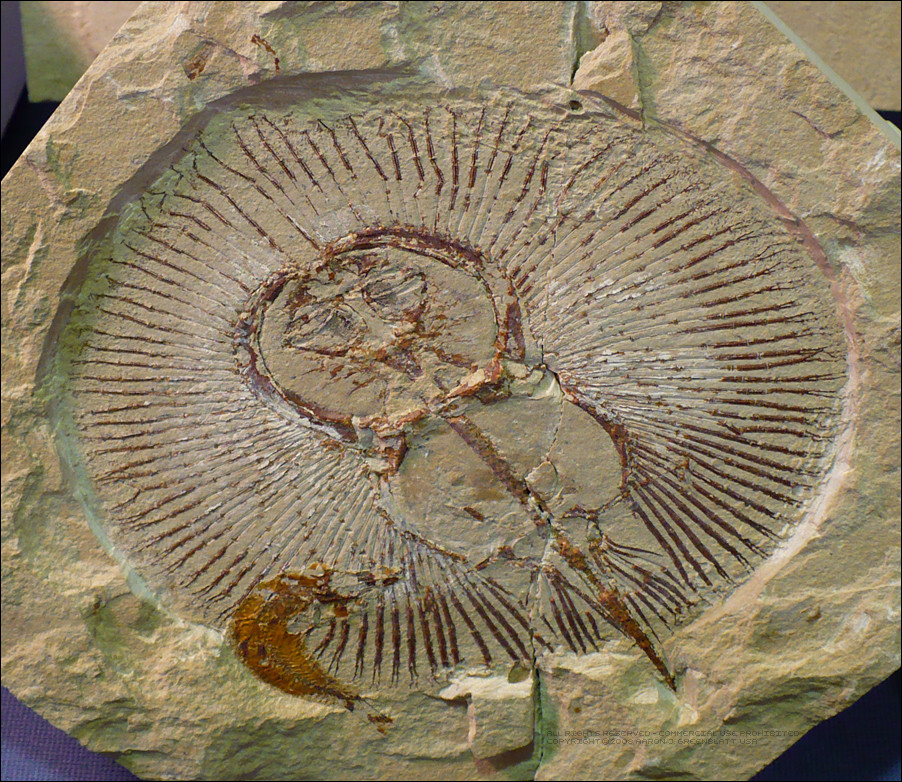HOME | DD
 Undistilled — Fossilized Stringray Closeup
Undistilled — Fossilized Stringray Closeup

Published: 2009-06-20 22:58:31 +0000 UTC; Views: 1929; Favourites: 13; Downloads: 22
Redirect to original
Description
(please click image for full view and scroll right)Title: Fossilized Stringray Closeup
Medium: Digital Photography
Photographer: Aaron J. Greenblatt
Camera Type: Panasonic DMC-LZ7 Lumix 7.2 MP
Editing: Edited in PhotoShop 7.0 for color accuracy, size, and to apply copyright and border.
Location: Photograph taken at the 2008 Southeastern Michigan Gem and Mineral Show at the Southgate Civic Center in Southgate, Michigan. Show hosted by the Midwest Mineralogical & Lapidary Society .
Description: This is a closeup image of the fossilized remains of a stingray. This fossil was sitting on a fossil dealer's table at the show and was for sale for $600. This is a repaired fossil. Originally it broke in two and you can see where the crack runs from the top of the slab to the bottom of the slab and is just off center from the middle of the fossil. This breakage obviously didn't affect the price of this specimen and it's still a superb fossil which contains stunning detail. As well, there is a bonus creature - what appears to be a fish near the bottom. Whether the stingray was eating the fish when it died I don't know, but having the fish there just adds even more interest to this fascinating specimen.
This fossil was found in Germany. To be more precise, it was found in Germany's Solnhofen limestone - a Jurassic Konservat-Lagerstätte that preserves a rare assemblage of fossilized organisms.
Some of of those organisms, such as sea jellies, don't ordinarily fossilize at all. Others, like the early bird Archaeopteryx are preserved in such detail that they are among the most famous and most beautiful fossils in the world. The Solnhofen beds lie in the German state of Bavaria (Bayern), halfway between Nuremberg (Nürnberg) and Munich (München).
More of my Solnhofen limestone fossil deviations can be seen by clicking on these links:
Fossil Fish
Fossilized Fish
Fossilized Fish and Shrimp
Fossilized Shrimp
Fossilized Lobster
Fossilized Crustacean
Fossilized Stingray
About Stringrays: The stingrays are a family of rays called Dasyatidae. They are a type of cartilaginous fish which are related to sharks and they are common in coastal tropical marine waters throughout the world. Several species are also known to enter fresh water.
Stingrays are usually very docile, their usual reaction being to flee any disturbance. Nevertheless, certain larger species may be more aggressive. The stingray's defensive reflex may result in serious injury or death from being speared by its stinger - which usually breaks off in the wound. Contact with the stinger causes local trauma (from the cut itself), pain and swelling from the venom, and possible later infection from bacteria. The stingray itself is not harmed by losing its stinger and will regrow it at the same rate that humans regrow their fingernails.
Information Sources:
[link] (wiki - Solnhofen Limestone)
[link] (wiki - stingray)
Legal: Copyright © Aaron J. Greenblatt. All rights reserved. Commercial use prohibited. This image and commentary may not be used for any reason without expressed written consent.
Please click here to view my photography work located in my Gallery.
Please click here for images of my glass work located in my other Gallery.
Please click here for images of my glass studio located in my other Scraps.
Related content
Comments: 16

👍: 0 ⏩: 0

Oh shoot. I just realized this.
This stingray is a Cretaceous Lebanon fossil. [link]
To date, I know no Solnhofen stingrays.
Sorry for any inconvenience : x
👍: 0 ⏩: 2

If it helps you any, I identified a few of your fish.
[link] is Nematonotus longispinus [link]
[link] that fossil is painted lol. Its a Halec microlepis [link]
[link] this one was really hard. Spent an hour looking and found a similar fossil [link] They call it a Halec. I doubt it is though. I was thinking more along the line of a species of the Nematonotus genus because of it's dorsal fin and overall body shape. I'll let you know if I find any different.
👍: 0 ⏩: 0

I'm not a fossil expert. My information comes from what the dealer at the show labeled this specimen as. It could indeed have been labeled incorrectly. And it certainly wouldn't be the first time that a dealer has goofed.
I've personally wondered if this specimen might be from the Green River formation in Wyoming.
👍: 0 ⏩: 1

It's no problem!
Identifying fish can be pretty hard. In some cases Solnhofen matrix and some fish look exactly the same as Lebanon material.
I see a lot of mix-ups with Knightia and Diplomystus.
👍: 0 ⏩: 1

Yeah, identifying fish can indeed be hard, especially since so many can look alike except for very small detail differences.
👍: 0 ⏩: 0

Incredible detail. How big is this? The fish at the bottom is certainly a bonus! They must have gotten buried very quickly, the fish died after the stingi but both got compressed rapidly.
👍: 0 ⏩: 1

This slab was a bit more than 10 inches across.
👍: 0 ⏩: 0

I like the roundness of this one, and the fish one, but I think this is better
👍: 0 ⏩: 1

I also find the symmetry pleasing as well.
👍: 0 ⏩: 0

Crazy to see how their shape is made, I couldnt tell what this could possibly be at first.
👍: 0 ⏩: 1

I was amazed by the number of bones.
👍: 0 ⏩: 0

Wow, amazing detail I must say, and quite a rarity. If only my jellyfish fossil from Mazon Creek were so well preserved...it's just a circle afterall. But...
👍: 0 ⏩: 1

Agreed.
I was also pleased with how the image came out. I never know in a show environment whether I'll be able to capture the detail or not.
👍: 0 ⏩: 0




























